Iris Musolf
Die Blaue Klinge
Installation Views
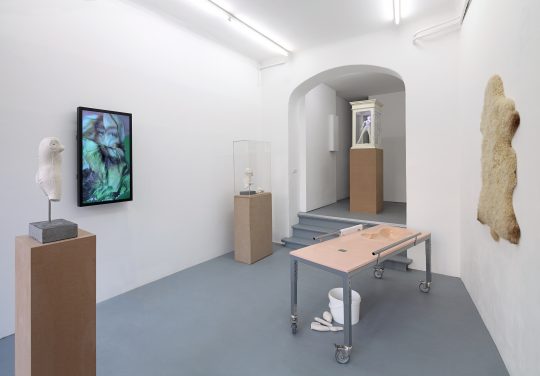
Installation view: Iris Musolf at Galerie Gilla Loercher 2014
Photo: Cordia Schlegelmilch, courtesy Galerie Gilla Loercher

Installation view: Iris Musolf at Galerie Gilla Loercher 2014
Photo: Cordia Schlegelmilch, courtesy Galerie Gilla Loercher
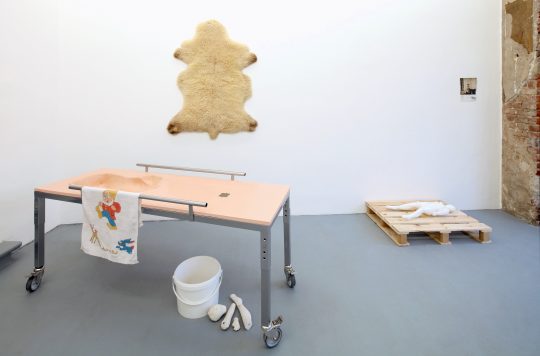
Installation view: Iris Musolf at Galerie Gilla Loercher 2014
Photo: Cordia Schlegelmilch, courtesy Galerie Gilla Loercher
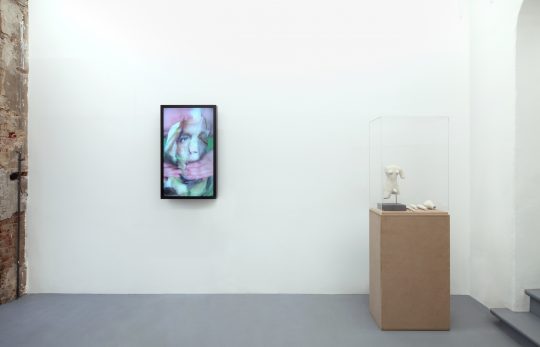
Installation view: Iris Musolf at Galerie Gilla Loercher 2014
Photo: Cordia Schlegelmilch, courtesy Galerie Gilla Loercher
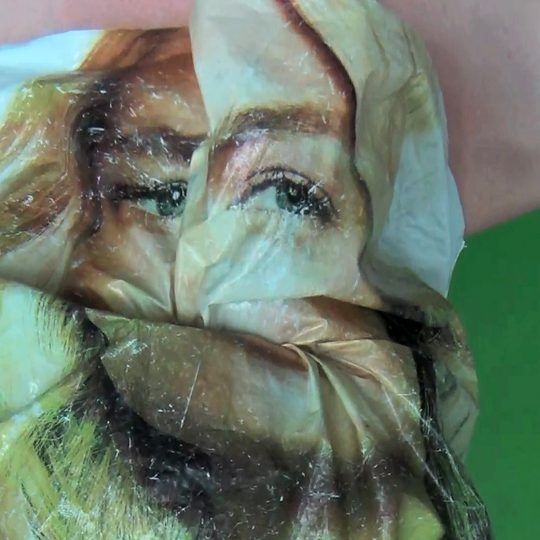
Installation view: Iris Musolf at Galerie Gilla Loercher 2014
Photo: Cordia Schlegelmilch, courtesy Galerie Gilla Loercher
Works

Area 52 Alien Travel Size Love Doll, 2013 Jahre n. Chr., 2013
Plaster, stone, steel, MDF,
165 x 28 x 28 cm
Photo: Cordia Schlegelmilch, courtesy Galerie Gilla Loercher
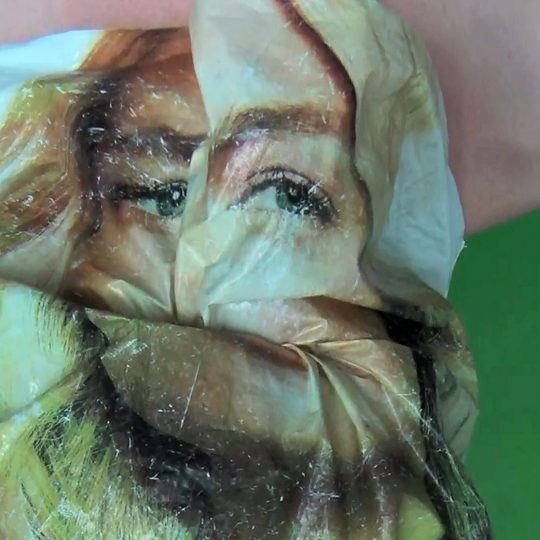
Becoming It, 2014
Video, 07:24 Min, Loop, 16:9, Sound, Full HD
Edition 5 +2 AP
Photo: Iris Musolf
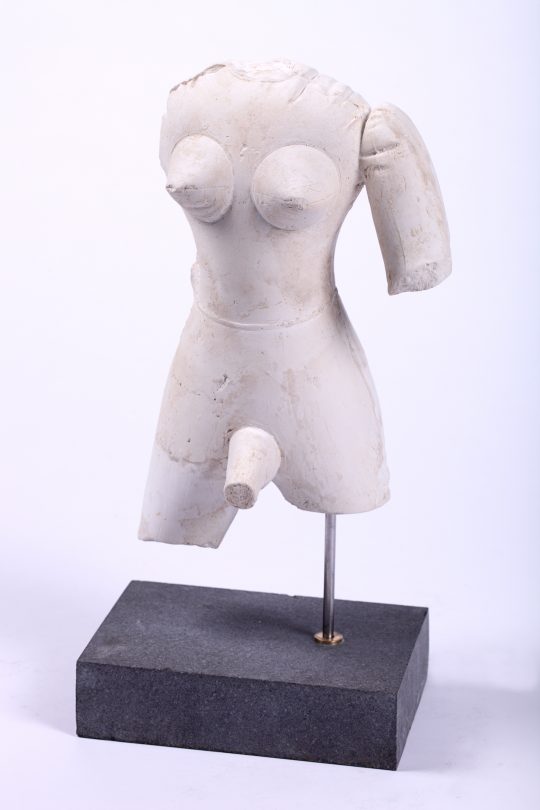
Transvestite Travel Size Love Doll, 2013 Jahre n. Chr., 2013
Plaster, stone, steel, MDF, acrylic
185 x 60 x 30 cm
Photo: Cordia Schlegelmilch, courtesy Galerie Gilla Loercher

Myoplastischer Tisch, 2014
Acrystal, pulverbeschichteter Stahl, Plastazote, Aluminium,
Love Doll Bones (Gips)
170 x 61 cm x Höhe variabel
Photo: Cordia Schlegelmilch, courtesy Galerie Gilla Loercher

Bottom Drawer (Aussteuer), 2014
Acrystal, varnish,
65 x 32 x 28 cm
Photo: Cordia Schlegelmilch, courtesy Galerie Gilla Loercher
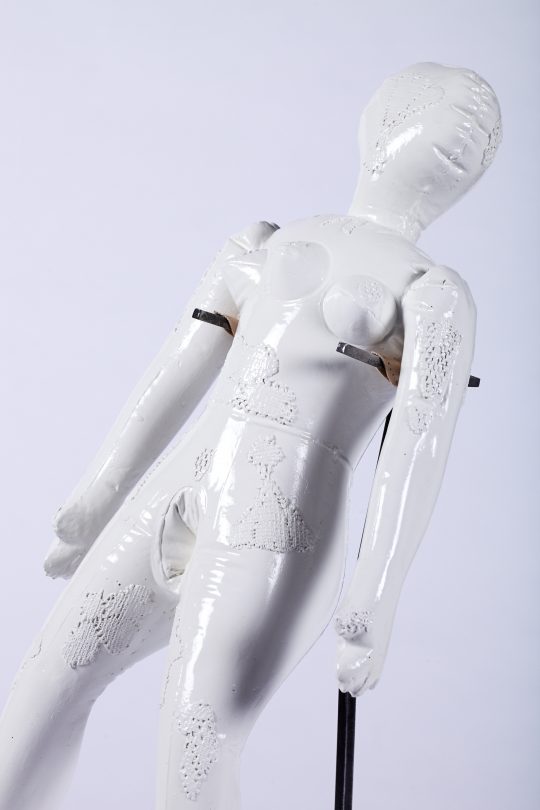
Bottom Drawer (Aussteuer), 2014
Acrystal, varnish,
65 x 32 x 28 cm
Photo: Cordia Schlegelmilch, courtesy Galerie Gilla Loercher
Press Release
/Artist statement IRIS MUSOLF:
„I am fascinated by the functionalisation of the cult of the body. We are surrounded by the adoration of the unreal body and the simulation of pleasure. I ask myself why. To conceal something? To ban whatever is intoxicating, disinhibited, ecstatic, abhorrent of the body? In my opinion, pornography is certainly a part of this. “Sex sells. And so, every industry has become a branch of the sex industry,” is how Laurie Penny formulated it. My work expresses a perceived cultural trauma, whose symptom is the body. The body is a commercial resource and an industrial production material. I see pornography as the exaggerated pleasure of frictionless processes, in which the intimate bodily experience is placed at the service of a production process for profit maximisation. During this process the differences between these bodies disappear and the bodies are turned into stylised image surfaces. By means of technical possibilities the human body is thus utilised as a clean foil for commercial purposes.”
A catalogue (with an interview: Candice Breitz in conversation with Iris Musolf) accompanies the exhibition. Edition: Galerie Gilla Loercher.
Interview excerpt:
Candice Breitz: [Your Video] Becoming It made me think of a chapter titled ‘Tolerances of the Human Face’ in J.G. Ballard’s Atrocity Exhibition, a text that on the one hand reads like an instruction manual on how to disrupt the mass media landscape, but which also brutally describes the extent to which consumer imagery has invaded and splintered contemporary consciousness, producing a brand of psychosis that is not easily sidestepped. Ballard embraces pornography as “a powerful catalyst for social change,” claiming in The Atrocity Exhibition that “its periods of greatest availability have frequently coincided with times of greatest economic and scientific advance.” While your work shares with Ballard’s writing an obsessive interest in prostheses, an almost clinical use of pornographic imagery and an investment in exploring the manner in which the human psyche has been almost physically penetrated by mass media imagery, you seem decidedly more ambivalent about the radical potential embedded in pornography. Can you speak about the recurring appearance of pornographic devices and references in your work?
Iris Musolf: This work is more concerned with the commercialisation of beauty and sexuality. I am fascinated by the functionalisation of the cult of the body. We are surrounded by the adoration of the unreal body and the simulation of pleasure. I ask myself why. To conceal something? To ban whatever is intoxicating, disinhibited, ecstatic, abhorrent of the body? In my opinion, pornography is certainly a part of this. “Sex sells. And so, every industry has become a branch of the sex industry,” is how Laurie Penny formulated it. My work expresses a perceived cultural trauma, whose symptom is the body. The body is a commercial resource and an industrial production material. I see pornography as the exaggerated pleasure of frictionless processes, in which the intimate bodily experience is placed at the service of a production process for profit maximisation. During this process the differences between these bodies disappear and the bodies are turned into stylised image surfaces. By means of technical possibilities the human body is thus utilised as a clean foil for commercial purposes.
Candice Breitz: Becoming It is a portrait of sorts, a self-portrait made under extreme physical duress. You are literally inverted and virtually suffocated as you wrestle with the plastic bag, not to mention denied any form of dignifying subjectivity. The ‘it’ in the title may refer to you or to the bag—both seem equally devoid of being. I’d be interested in hearing more about the process of ‘becoming’ that you allude to in the title of the work, given that little visible growth or progress occurs as we watch you (an objectified subject) losing your identity to the bag (a subjectified object).
Iris Musolf: At the end of the video I try to become one with the face of the model projected on the bag. The attempt to chew and to eat the face entails, for me, the process of incorporative becoming. At the same time, the work addresses the possibility of becoming this other I. Here it is the image of a model, a person charged with ideal conceptions of beauty and thus with idealised social norms as well. The work is about how one can define oneself through the body and simultaneously against it. For me this is a personal and social issue. I want to “become body, where none is,” as Hans Belting said. I question this becoming, “which increasingly substitutes the being of the body in our world by the appearance of the image” (Belting). The bag as the carrier medium for the photographed face of the model is also a prosthesis, which in turn is continued in the technical surface of the flat screen, where everything coincides for the seeing eye and becomes one.
(Translation: by David Sanchez)